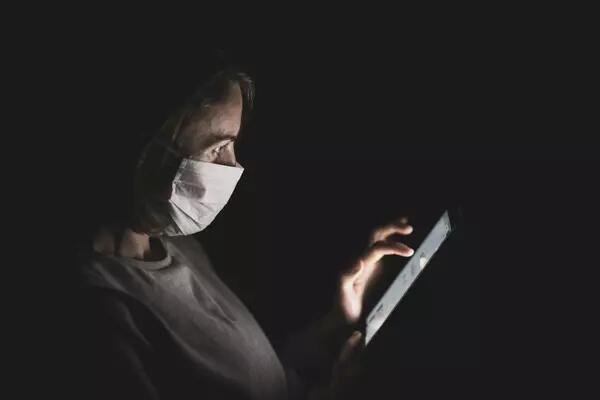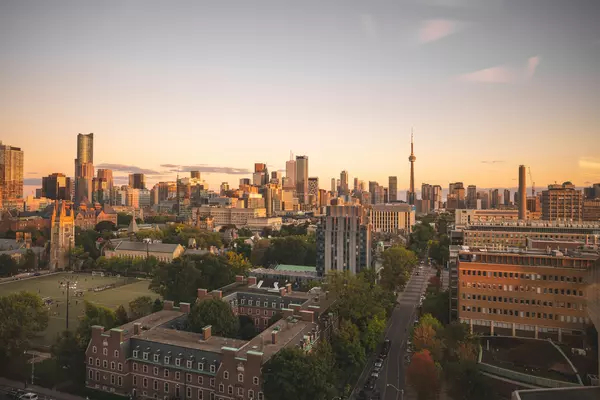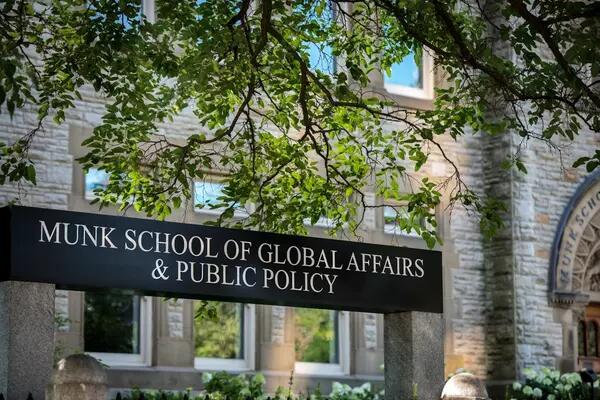Alexandra Rahr has served as the first Bissell-Heyd Lecturer in American Studies at the Centre for the Study of the United States. She completed her Ph.D. in the Department of English at the University of Toronto. Her dissertation, written under the direction of Professor Andrea Most, examined the genealogy of disaster narratives in American literature and makes a landmark contribution to the growing field of environmental humanities. Rahr is now the director of Undergraduate Programs and Student Experience at the Munk School.

Congratulations on your appointment. How does it feel?
Oh, it’s so exciting. It just feels like a wonderful opportunity and I think the position itself, which is brand new, signals how invested the Munk School is in undergraduate education. It really speaks to the School’s leadership, and says that undergraduates aren’t an afterthought — they are absolutely essential to the mission and the future of the Munk School.
You served as the first Bissell-Heyd Lecturer in American Studies at CSUS. Can you talk a little bit about how that position converged with your own personal interest in the environmental humanities?
The Bissell-Heyd Lectureship was a fabulous job. It was an exciting place to be at an exciting time. It also allowed me to work closely with undergraduates on programming and curriculum, and ask them important questions like, “what are you interested in? What classes should we be offering next year? What are we missing? What do we need to do that we’re not doing?”
One of the things I heard consistently was that we need to focus more on the environment, the climate crisis — and what we can do about them . This emphasis dovetailed with my own research is in the environmental humanities. I read, write and think about so-called natural disasters, which are actually not very natural at all when you dig into them. What happens when flood, drought and storms afflict the republic? How does America think, talk, write and make sense of the disasters that have occurred over the last 250 years? And what are the consequences of the ways that we think and imagine what is catastrophic and what is not?
Being the Bissell-Heyd Lecturer gave me a chance to explore some of those ideas. This last winter, I taught a seminar on climates in crisis and the students were outstanding. They were engaged and thoughtful, they drove the class, grappled with tough, thorny issues; and came up with creative solutions. It was a real joy to be able to work with such thoughtful, incisive, and engaged undergraduates on such critical issues.
What kind of solutions did they talk about?
They were really interested in the cultural assumptions and beliefs that inform public policy. Questions like: What is humanity’s relationship to nature? What is our proper relation to the natural world? Who is responsible for environmental degradation? How do we decide what toxicity and degradation is acceptable – because we do accept these, every single day? Whose communities, whose water supplies, whose health is sacrificable – and whose is not?
One of the big ideas that came out of the class was a real resistance to the consumer model of environmentalism. You know, the one that says, “you just need to shop differently. You need to buy different things in different ways. You need to recycle. If you’re not recycling, you’re killing the planet. If you are, you’re done – you’ve saved the planet!”
The students were really alert to the problems with that kind of individuation. They recognized that climate is a collective problem — each of us cannot individually shop or recycle our way out of it. We need collective, sociocultural changes and, and those changes require collective action.
That sociocultural shift seems almost impossible unless corporations take on some of that blame. Do you see that happening? How feasible is that?
A big problem is the sense of paralysis — the feeling that the climate crisis is so big that we can’t do anything about it. That eco-anxiety is tough. How do you teach this stuff without inculcating despair?
My students were really thoughtful about the fact that despair and action are both political positions. There are things that we can do. We are not out of chances or strategies. We need to think collectively about ways we can bring pressure to bear on lawmakers, use the electoral cycle, and learn from past protest movements. There are all kinds of ways into making social change, from the local level to a global one.
But believing that we’re stuck works to the benefit of some actors who don’t want to make change. It’s important to see hope not just as a feeling, but as a strategy. In times of crisis, hope is a political position
You mentioned “so-called” natural disasters, alluding to the idea that they are not, in fact, “natural.” Can you elaborate?
There’s an emerging field called critical disaster studies that’s interested in more than just reporting what happened. It’s not just saying, “a tsunami occurred, and here’s the amount of property damage or here’s the number of people who died.”
Critical disaster studies takes disaster itself as an object of study. It asks, “how do we think about catastrophe critically?” One of the ways to do that is to think about the terms we use to describe these events. Calling something a ‘natural disaster’ has huge consequences, because if you believe that something is natural, you believe there’s a kind of inevitability to it. “Natural” implies that these catastrophes are unavoidable, cannot be prevented or mitigated, and that we have no role in their causation – we’re just at the mercy of something beyond us.
And while it’s certainly true that tornadoes and hurricane are acts of nature, it’s also true that human behaviour shapes both those events, and their consequences. When Hurricane Katrina hit New Orleans, the worst damage wasn’t caused by the hurricane, but by the failure of the levee system. Hurricane Katrina was not, by the time it got to New Orleans, a horrible storm. It was under-maintained infrastructure that really put New Orleanians at risk, and people knew that long before Katrina hit.
In Spike Lee’s fabulous documentary about Katrina, called “When the Levees Broke,” he interviews a local radio host named Garland Robinette. Robinette says, so memorably, “people think we got hit by a hurricane. We got missed by a hurricane.” New Orleans got hit by an abandonment of infrastructure, among many other human-caused risk factors. That’s what made a disaster out a storm.
Another thing to keep in mind about Hurricane Katrina is that it happened near the end of a month, when people who receive government support were almost out of money. It’s really tough to evacuate when you don’t have any money. How do you buy a bus ticket? Where do you stay after you escape the flood zone? There are so many ways in which racialized people, especially Indigenous and Black people, are at much higher risk for both the short- and long-term effects of natural disasters.
Keep in mind that disasters rarely create inequity. They just pull the veil away from the inequity that was always there. It becomes more raw and more visible, and people who have more privilege are forced to see it, on the news and on their phones.
One last question: what is your vision for your role as director of Undergraduate Programs and Student Experience?
The vision for this job is to create a more cohesive experience for undergraduates, and to ensure that they have rich intellectual and community experiences at the Munk School. We want students to thrive and feel connected, not like they’re floating in their own separate little bubbles.
This autumn, I’m holding open houses for students to come and talk to me. I’m really looking forward to hearing what students need, so we can work together to design initiatives that address those needs. We want students to have a sense of the opportunities and connections that the Munk School can offer them, and to get to know their classmates in different Munk programs. When our students graduate, we want them to leave the Munk School feeling enlivened and connected to a deeper social and intellectual world than when they arrived.
Photos courtesy of Kristen Wells



